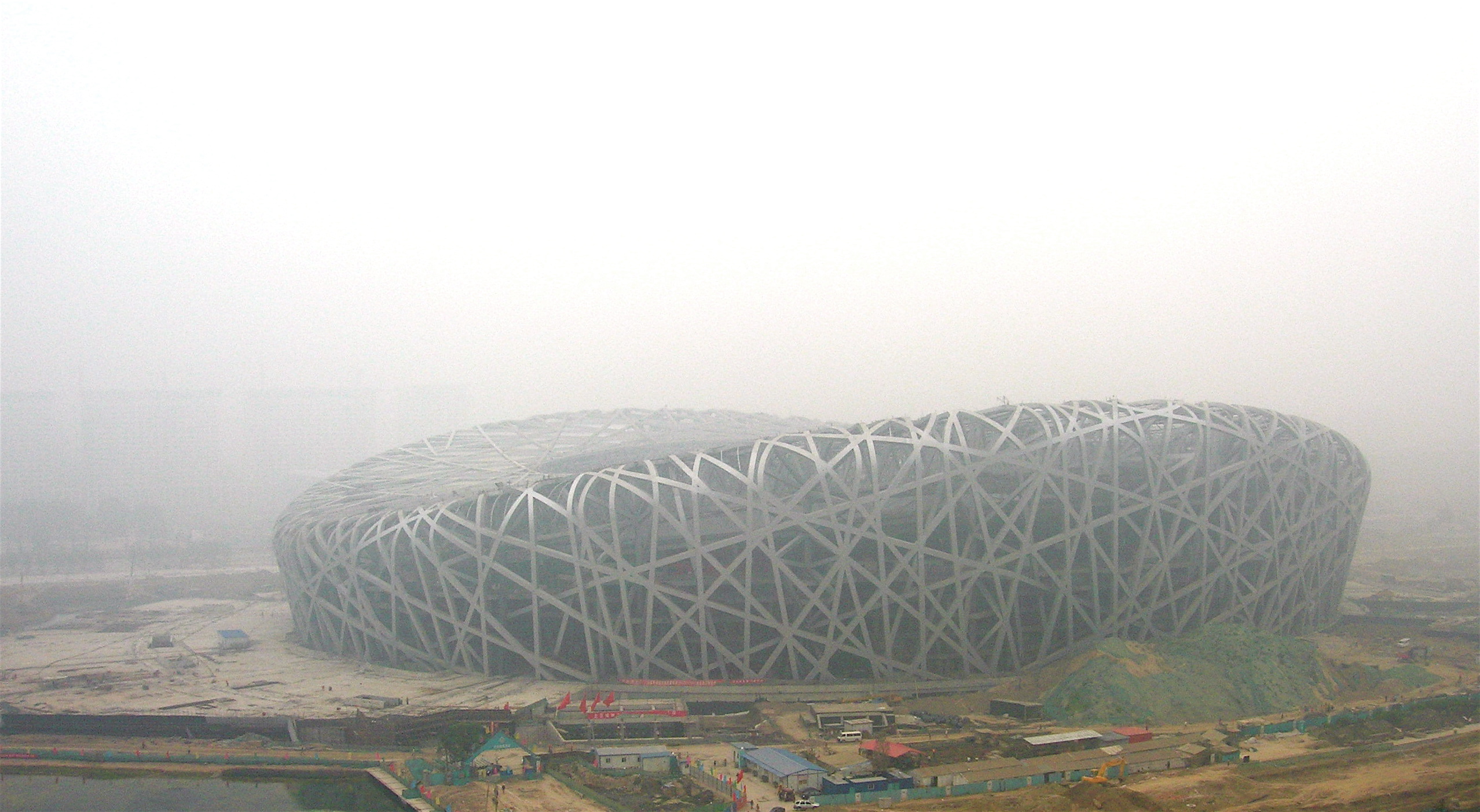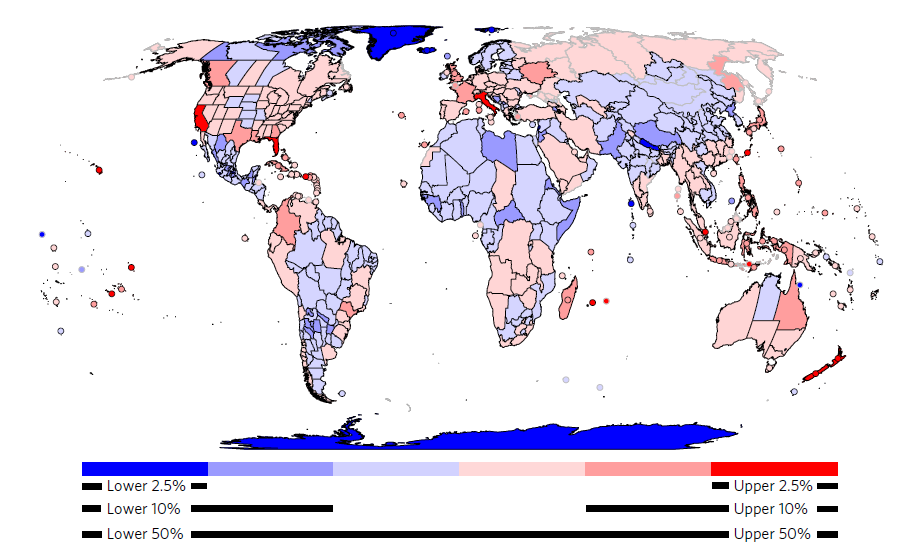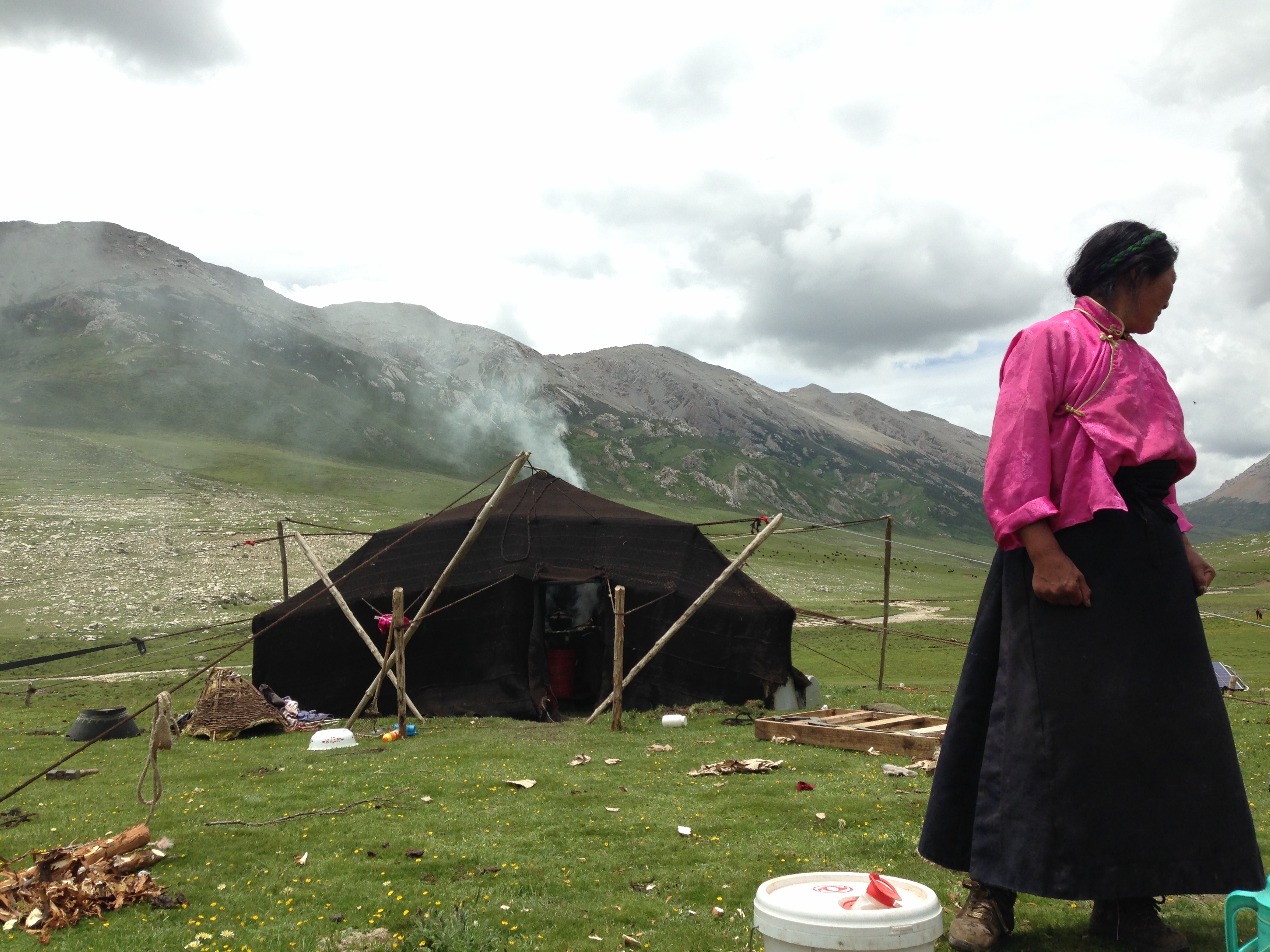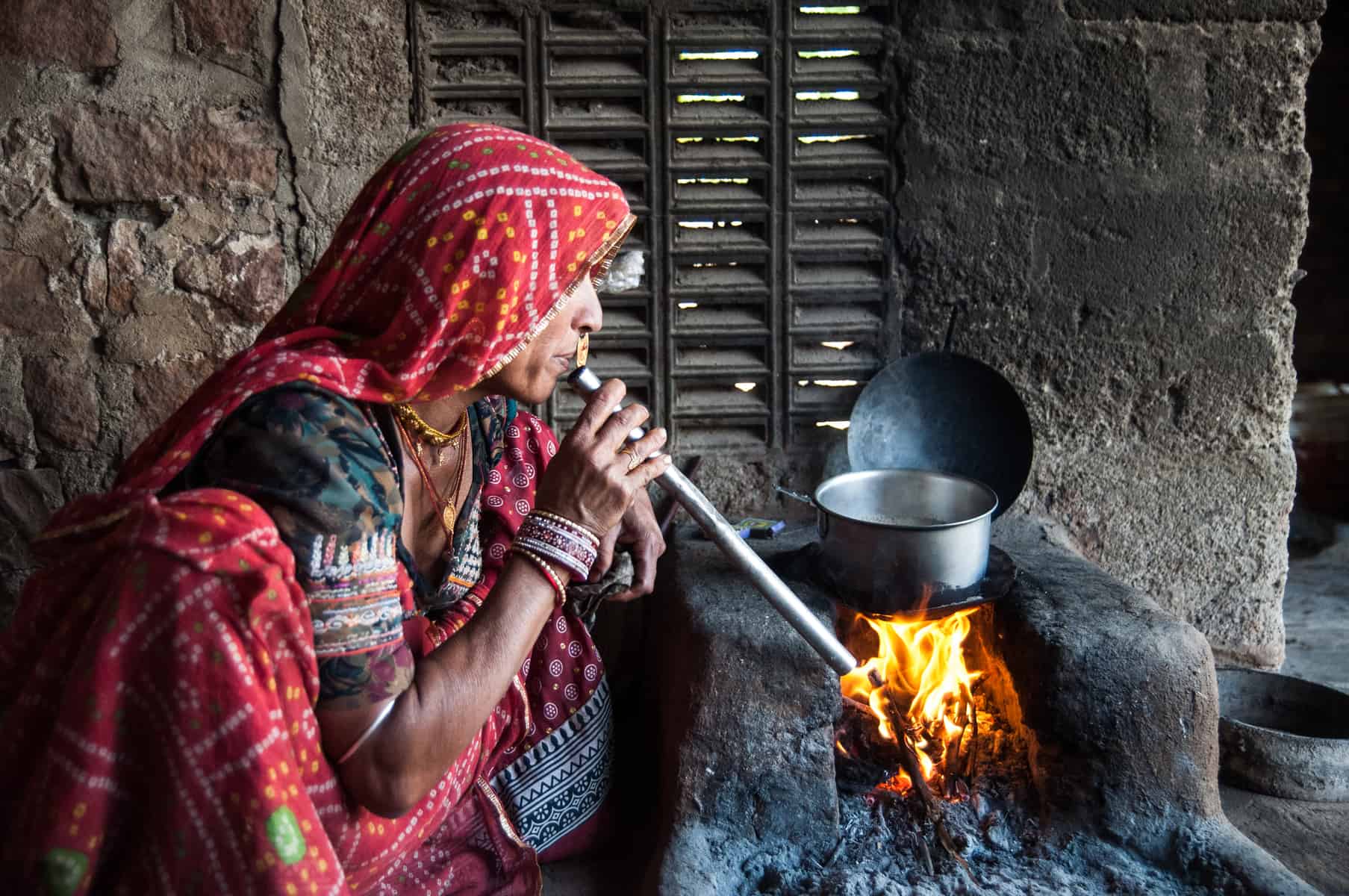Aug 31, 2017 | Air Pollution, Health
By Caroline Njoki, IIASA Science Communication Fellow 2017
The Olympic Games creates a spectacle that enthralls the world every four years. Countries enter a competitive bidding process to select a new host, hoping to enhance their international image and attract tourism. Among many other preparations, the host nation commits to meeting recommended air quality standards to safeguard the health of athletes, visitors, and residents.
Studies indicate that air pollution can affect performance and compromise the health of those engaged in competitive sports and outdoor physical activities. Through his presentation at IIASA in July, Professor Tong Zhu from the College of Environmental Sciences and Engineering at Peking University expounded on health effects arising from a major air pollutant: particulate matter measuring 2.5 microns or less, known as PM2.5.

The Bird’s Nest Stadium, Beijing Olympics 2008 © rytc | flickr
PM2.5 is made up of fine particles smaller than human hair, pollen or mold. These tiny particles are released into the atmosphere from many sources: burning solid fuels and waste, wildfires, emissions from industry, vehicles, construction and mining, volcanic eruptions, and dust. ‘‘It is difficult to tackle particulate matter as its chemical composition changes when it mixes with other substances in the air. It can also be transported far from the different sources depending on weather conditions and topography,’’ said Zhu.
Once inhaled, the minute particles travel deep into the lungs and enter the bloodstream, leading to impaired brain, respiratory, and heart function. Lung cancer, stroke, chronic obstructive pulmonary disease and lowered life expectancy are all associated with PM2.5 exposure. Taking part in oxygen-demanding physical activities such as long-distance races, jogging, and cycling requires breathing more through the mouth than nose. This increases the likelihood of inhaling harmful pollutants, especially in areas where concentrations are high.

Hosting international sport events such as the Olympics Games comes with commitment to improve air quality standards to safeguard the health of athletes, visitors, and residents © Pete Niesen | Shutterstock
China is a densely populated and industrialized country with coal as the main source of energy. Eighty-three percent of China’s population live in regions whose PM2.5 levels exceed World Health Organization’s guidelines, compared to 32% of the world population. Use of coal for domestic heating goes up during the winter, generating more particulate matter pollution indoors. In 2010, 1.2 million people died in China as a result of particulate matter pollution; it was the country’s fourth leading cause of death after diet, high blood pressure, and smoking. ‘‘Electricity would be a better option but is highly priced, hence the preference for biomass fuels by residents. Phasing out coal and switching to renewable energy and cleaner production technologies would greatly alleviate the problem,’’ said Zhu.
Zhu was involved in several initiatives to improve air quality in preparations for the 2008 Beijing Olympics. Measures included temporary relocations of more polluting industries and complete shutdown of coal plants, limiting construction projects, and transport restrictions. For instance, public transport and cycling was promoted to cut the number of vehicles on the road and reduce emissions.
Although short term, steps taken to reduce PM2.5 and other pollutants also benefited locals living in Beijing and adjacent cities that were selected as sporting and training venues. This meant fewer people seeking outpatient and inpatient medical services, and fewer deaths. The economy also benefited from a healthy labor force.

Professor Tong Zhu and Verena Rauchenwald from the Air Quality and Greenhouse Gases Program after the presentation on health effects of PM2.5 at IIASA © Caroline Njoki | IIASA
IIASA’s own work on air pollution spans 30 years, has shaped EU air pollution policy, and is now being applied to Asian countries including China. The IIASA Greenhouse Gas and Air Pollution Interactions and Synergies model enables countries to identify and select suitable cost-effective measures to tackle air pollution and reduce associated health problems.
The PM monitoring in China, which was initiated for the Olympic Games, using both satellite and ground-based observations, continues and has been expanded to cover more sites in the country. Information generated about air quality status is now distributed to concerned authorities to develop or reinforce regulatory measures. Air quality alerts enable residents know when it is safe to engage in outdoor activities or adopt safety measures.
China anticipates cleaner air from implementation of long-term policies and programs already in place. Investing in air quality means healthier people and alongside that, lively stadiums with athletes and cheering crowds, more medals, and world records.
References
Rich DQ, Kipen HW, Huang W, Wang G et al (2012). Association Between Changes in Air Pollution Levels During the Beijing Olympics and Biomarkers of Inflammation and Thrombosis in Healthy Young Adults. JAMA 307 (19): 2068-78
West JJ, Cohen A, Dentener W, Brunekreef B et al (2016). What We Breath Impacts Our Health: Improving Understanding of the Link Between Air Pollution and Health. Environmental Science and Technology 50: 4895-4904
Zhu T (2017). Health Effects of PM2.5 in China: Scientific Challenges and Policy Implications. Presentation by Professor Tong Zhu on 11 July 2017 at IIASA.
This article gives the views of the author, and not the position of the Nexus blog, nor of the International Institute for Applied Systems Analysis.
Aug 11, 2017 | Ecosystems, Young Scientists
By Caroline Njoki, IIASA Science Communication Fellow 2017
Wealthier regions with high population densities have the largest influxes of non-native species, a new study has found. This is mainly because of global trade and strong transport links, the researchers concluded.
Researchers assessed global patterns from 609 regions consisting of 186 islands and 423 mainland regions. Using available global and national databases as well as a thorough literature search for eight taxonomic groups (vascular plants, birds, freshwater fishes, ants, spiders, amphibians, mammals and reptiles), they identified hotspots with high and low diversity of non-native species. Socioeconomic and environmental factors such as climate were also taken into consideration.

Map showing hotspots with high (dark, medium and light red) and low (dark, medium and light blue) diversity of non-native species across the eight taxonomic groups. Source: Dawson W et al. (2017).
The results indicate that remote and highly populated islands, developed countries, and nations with fast growing economies have the greatest influxes of invasive species from across the taxonomic groups due to reliance on foreign commodities. This also applies to coastal regions that have seaports serving as import hubs for non-native birds and aquatic organisms. The rate of invasion is especially high on islands and in coastal regions with warmer climates.
Native, endemic, and rare plants and animals could be particularly vulnerable in these regions, especially if the absence of predators or reduced numbers of competitors on islands allows invasive species to thrive. Under climate change, urbanization, and land-use intensification, non-native species might also be able to increasingly spread into environments that were previously unviable for them.
‘‘Horticultural products from other regions are among the commodities accounting for a large influx of non-native plants and arthropods (spiders), especially in Europe and North America,” said coauthor of the study Bernd Lenzner, a PhD student at the University of Vienna and a participant in the IIASA Young Scientist Summer Program.

Lenzner’s work at IIASA to predict future patterns up to year 2050, is critical to help guide development of appropriate strategies to tackle species such as the Hottentot fig (seen here with purple flowers) originally from South Africa but invasive in Mediterranean coastal habitats © Bernd Lenzner | IIASA
Several regional initiatives enabling the public to participate in monitoring and reporting of invasive species through user-friendly digital applications exist, like the “Invasive Alien Species Europe” app. This contains photos and fact sheets of a number of species that have become invasive in Europe to allow users to identify and submit information regarding occurrences of species of concern.
Lenzner’s current work at IIASA is to develop models indicating likely future patterns of invasive species at a global scale by integrating data from several models, including the IIASA Global Biosphere Management Model. Construction of the models is based on information collated from climate change, population dynamics, the resilience of native biodiversity, legislation, trade, transport activities, and land-use and land-cover change. The research will provide predictions up to the year 2050, to guide policymakers to develop appropriate strategies to tackle non-native species.
To ensure wider applicability, the work is linked to the IIASA-led Shared Socioeconomic Pathways (SSPs). The SSPs provide alternative explanations on how various elements, such as governance, urbanization, and economic growth, might develop in the future. Some of these factors will have crucial impacts on the displacement and establishment of non-native species.
“Forecasting future scenarios, though necessary, may be hindered by uncertainty over the probable impacts, and scattered and insufficient data. This is further complicated by a lack of a clear definition of invasive species. More funding and research effort are required to generate comprehensive information vital for effective management of invasive species if the Aichi Target 9 by the Convention on Biological Diversity is to be realized by year 2020,” says Lenzner.

Nile perch was introduced to Lake Victoria, East Africa for its beneficial traits but has eliminated many native fish © Fotogien | Shutterstock
Global trade has developed rapidly, with advances in transport enabling easier and faster movement of goods and people in high volumes. The rising human population also drives the demand for commodities. This global trade network opens the door for species to spread across the world. In addition, non-native species are sometimes deliberately or accidentally introduced, often in the form of ornamental, agricultural, and forestry products, or because of research, natural disasters, and the pet trade.
“Some countries introduce species for their beneficial traits without conducting proper risk assessments, only to suffer from the resulting impacts later on. For instance, Nile perch in Lake Victoria, East Africa has eliminated many native and endemic fish. It takes a while for certain introduced species to exhibit invasive characteristics as they adapt to their new environment or conditions become more favorable,” said Lenzner.
The findings are important, especially for countries at greater risk of invasion, to help policymakers put measures in place to stop further introductions and the spread of non-native species. The move aims to safeguard human health, economies, infrastructure, native organisms and associated environmental goods and services.
About the researcher
Bernd Lenzner is a third year PhD student at the Division of Conservation Biology, Vegetation and Landscape Ecology at the University of Vienna. His research focuses on understanding spatial and temporal patterns and processes of global naturalized alien plant species richness and assembly. At IIASA, Bernd is working with the Ecosystem Services and Management Program to develop the first global scenarios for biological invasion in the 21st century under the supervision of David Leclère and Oskar Franklin.
References
Dawson W, Moser D, Kleunen M & Kreft H et al (2017). Global hotspots and correlates of alien species richness across taxonomic groups. Nature Ecology and Evolution 1: 0186
This article gives the views of the author, and not the position of the Nexus blog, nor of the International Institute for Applied Systems Analysis.
Jul 21, 2017 | Risk and resilience, Young Scientists
Ziyun Zhu is a PhD student at Peking University Centre for Nature and Society, and research assistant at the Shanshui Conservation Center, China. He is currently attending the IIASA Young Scientists Summer Program and talks to Science Communication Fellow 2017 Caroline Njoki about his current research on wildlife damage insurance schemes as a strategy to manage human-wildlife conflict.
What is your research about and what do you aim to achieve during your time at IIASA?
Wildlife insurance schemes compensate local people in case wild animals attack their livestock, or damage their crops or property, if a wolf kills a sheep, for instance. These schemes are a relatively new tool for mitigation of human-wildlife conflicts and there isn’t sufficient information on when this is the best option and where other tools may apply. My research is to clarify the different scenarios where insurance can work, based on existing insurance projects and other mitigation measures from other parts of the world. This will help improve insurance schemes for other areas.

Effective ways of managing human-wildlife conflicts are required to ensure survival of species such as the Snow leopard © Peter Wey | Shutterstock
Tell us more about the community wildlife insurance scheme?
The Tibetan Plateau contains unique wildlife including snow leopards, wolves, and Tibetan brown bears. The people living on the plateau keep yaks and sheep, and co-exist with wildlife. However, there are cases when interactions between people and carnivores result in conflict and disruption of people’s livelihoods, and may lead to retaliatory killing of wildlife.
A voluntary Community Wildlife Insurance Scheme, started by the non-governmental organization Shanshui Conservation Center in 2008, runs on premiums contributed by the members. This makes the scheme more self-sufficient than traditional government-funded compensation, which often lacks funding. The premium depends on type of animal (sheep or yak) and number they keep and also covers damage to their homes by bears. The validation process is also streamlined to ensure claims are paid out quickly.
Members meet annually to elect leaders to manage the pilot scheme, evaluate performance, and review the premiums in line with market trends. In consultation with the members, leaders determine the premium based on the market but also make them affordable. The members are also encouraged to put in place other mitigation measures.

A traditional tent made from yak wool. Tibetan people possess rich indigenous ecological knowledge © Lingyun Xiao
Herders have negative attitudes towards brown bears, yet bears attacking livestock is rare compared to other predators. Why is that?
The availability of pasture on the plateau is seasonal. Herders and their families lived in yak-wool tents until a government initiative to support them to build winter houses in the mid-1990s. When herders move from their winter to summer grounds, bears sometimes break into their mud brick houses, consume stored food, and damage property. The herders must then pay for repairs and replacements, hence the strong negative attitude towards bears. Working closely with local communities to raise awareness and develop suitable mitigation measures is key to promoting co-existence with wildlife.
What are your highlights from working on the Tibetan Plateau?

Ziyun Zhu treasures sighting a snow leopard in the wild and his work in the Tibetan Plateau offers him an opportunity to connect with nature away from city life © Caroline Njoki | IIASA
During fieldwork to determine presence of the snow leopards on the plateau, which are very shy and elusive, one dashed from above the cave and disappeared in the rocks while we were placing camera traps. This was definitely a highlight for me. I also enjoy working with the people, who possess a rich indigenous ecological knowledge. My PhD aims to document this information and how it may contribute to conservation of Tibetan’s biodiversity. For instance, the collection of plants and hunting of animals are not allowed in certain areas designated as sacred or of high cultural importance. There is little human interference, leaving much of the area pristine.
This article gives the views of the interviewee, and not the position of the Nexus blog, nor of the International Institute for Applied Systems Analysis.
Reference
Juan Li, Hang Yin, Dajun Wang & Ziyun Zhi (2013). Human-snow leopard conflicts in the Sanjiangyuan Region of the Tibetan Plateau. Biological Conservation 166: 118-123.
Jul 12, 2017 | Air Pollution, Demography
By Caroline Njoki, IIASA Science Communication Fellow 2017
Child mortality is high in Nigeria. For every 1000 children born, 128 deaths occur, according to the 2013 Nigeria Demographic and Health Survey report. This is one of the highest rates in Sub-Saharan Africa.
Although the Nigerian government is working hard to change the story and ensure more children live to celebrate their fifth birthday, through schemes such as free maternal and child healthcare, indoor air pollution may hinder those efforts if not addressed, research has shown.
Solid fuels and the health of children and women
“Indoor air pollution can have a severe effect on children’s health. For example, pneumonia, a major contributor of under-five mortality, will be exacerbated,’’ says Olugbemisola Samuel, a participant in the Young Scientist Summer Program who is currently working on a project to determine just how many lives could be saved by replacing solid fuels with clean ones in Nigeria.

Indoor air pollution poses a serious health risk to children and women in developing countries © Svetlana Eremina | Shutterstock.com
It is a common practice, not only in Nigeria but in many African and Asian societies, to find mothers carrying young children on their backs as they go about domestic tasks in the home. Women are likely to spend most of their time in the kitchen cooking, washing dishes, and heating water for drinking or bathing.
Cooking in rural households is done on traditional stoves where cow dung, crop straw, charcoal, and firewood are used. The smoke contains many harmful tiny particles and substances. If taken in small quantities over a long duration, this interferes with the respiratory system and can cause other health problems. In Nigeria, 80% of children under five years live in homes where wood is the main fuel used.
A 2016 report from UN Children’s Fund links the use of these solid fuels to respiratory diseases such pneumonia, asthma, bronchitis, impaired cognitive development, and cataracts among children under five years, especially in developing countries. For children and women with already weak immune systems from malnutrition, HIV/AIDS, tuberculosis or other chronic diseases, long-term exposure from indoor air pollutants can worsen the conditions.
Exposure to indoor air pollution during pregnancy and delivery can mean miscarriage, low birth weight, or children with stunted growth. A study carried out in India also associated the likelihood of developing preeclampsia (elevated blood pressure) while pregnant with long-term exposure indoor air pollutants.
Olugbemisola, in her current IIASA study, is using the Greenhouse Gas-Air Pollution Interactions and Synergies model to estimate the number of children under five years that may be prevented from dying if cleaner fuels (such as electricity and gas) are adopted. She hopes to share her findings with policymakers in energy and health sectors, especially in the areas severely affected by indoor air pollution and under-five mortality.
Tracing and addressing the problem
Income and wealth dictate the choice of fuel used in a household. Most rural households use solid fuel for cooking owing to their low income. In urban areas, where most people do have access to electricity, they may still rely on cheaper sources of energy such as charcoal and kerosene for cooking.

Making other cleaner forms of energy available and affordable is one way of reducing indoor air pollution (CC) Harsha K R
“Making electricity and gas available and affordable to households should be seriously prioritized by the government as a critical intervention to improve the situation. Currently, only 56% of households in Nigeria have access to electricity yet the country exports to neighboring countries such as Ghana and Benin,” says Olugbemisola.
Use of solid fuels is highest (at 98%) in the northeast region of the country, a survey by Nigeria’s National Bureau of Statistics revealed. This region also has high illiteracy, poverty, and rates of early child marriage. “Women with low or basic education lack adequate knowledge and information to enable them make informed choices as regards to maternal health, family planning, design or location of the kitchen including choice of cooking fuel”, says Olugbemisola.
She proposes innovative communication strategies to reach out to women, particularly in rural and remote areas with little or no education to raise awareness on the topic. The methods could include the use of performing arts, television and radio, and pamphlets prepared in vernacular languages to be made available at health facilities or distributed by community health workers.
Another area for improvement is the location and design of the kitchen. In most rural settings, the kitchen is either part of the main house or built separately but urban populations living in informal settlements usually occupy one room that doubles up as the sleeping and kitchen area. Poor ventilation traps the smoke and increases the concentration of tiny particles. Pollution could be reduced by installing chimneys, switching to improved cooking stoves and better ventilation to allow clear air to circulate in the kitchen.
Successful development and implementation of these interventions will help to see more children living to celebrate their fifth birthday.
References
Agrawal S & Yamamoto S. (2015). Effect of indoor air pollution from biomass and solid fuel combustion on symptoms of preeclampsia/eclampsia in Indian women. Indoor Air 25: 341-352
Gbemisola W. Samuel (2016). Underlying and Proximate Determinants of Under-five Mortality in Nigeria: Understanding the Pathways of Influence. Covenant University, Nigeria. PhD Thesis.
Gbemisola W. Samuel, Ajayi Mofoluwake P, Odowu E & Ogundipe Oluwatomisin M (2016). Levels and Trends in Household Source of Cooking Fuel in Nigeria: Implications on Under-five Mortality. Health Science Journal 10:4
This article gives the views of the author, and not the position of the Nexus blog, nor of the International Institute for Applied Systems Analysis.












You must be logged in to post a comment.